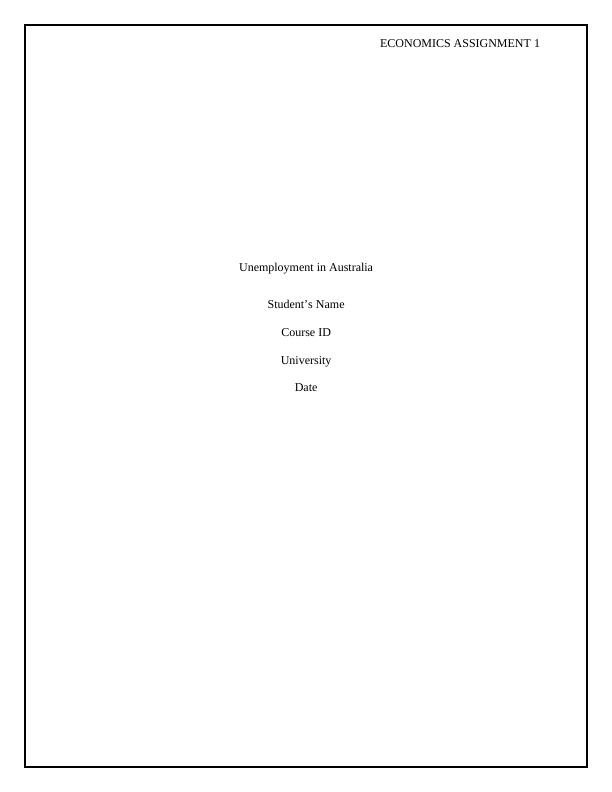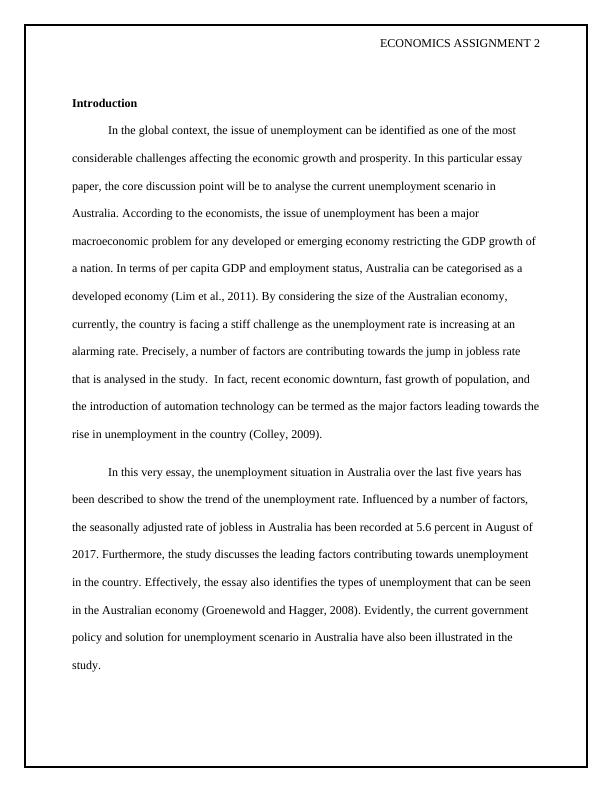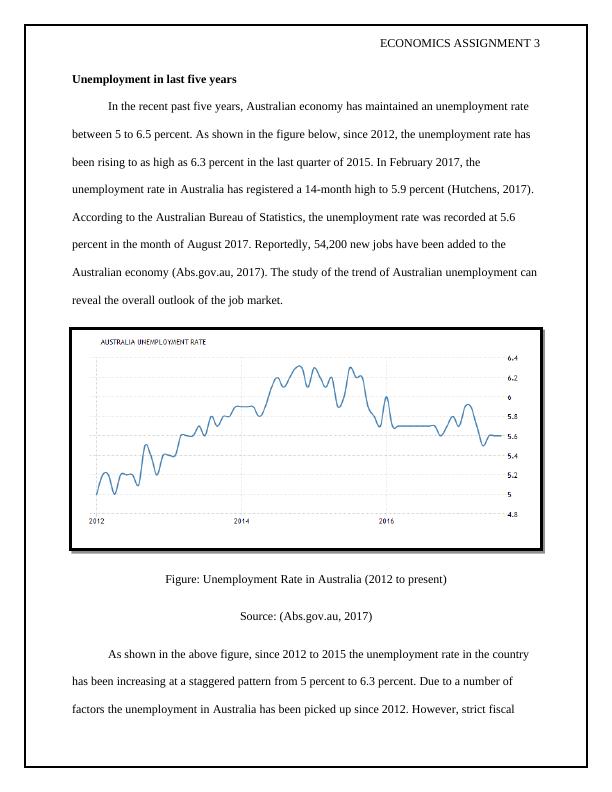Unemployment in Australia- Economics Assignment
16 Pages3705 Words63 Views
Added on 2020-03-16
Unemployment in Australia- Economics Assignment
Added on 2020-03-16
ShareRelated Documents
ECONOMICS ASSIGNMENT 1Unemployment in AustraliaStudent’s NameCourse IDUniversityDate

ECONOMICS ASSIGNMENT 2IntroductionIn the global context, the issue of unemployment can be identified as one of the most considerable challenges affecting the economic growth and prosperity. In this particular essay paper, the core discussion point will be to analyse the current unemployment scenario in Australia. According to the economists, the issue of unemployment has been a major macroeconomic problem for any developed or emerging economy restricting the GDP growth of a nation. In terms of per capita GDP and employment status, Australia can be categorised as a developed economy (Lim et al., 2011). By considering the size of the Australian economy, currently, the country is facing a stiff challenge as the unemployment rate is increasing at an alarming rate. Precisely, a number of factors are contributing towards the jump in jobless rate that is analysed in the study. In fact, recent economic downturn, fast growth of population, and the introduction of automation technology can be termed as the major factors leading towards therise in unemployment in the country (Colley, 2009). In this very essay, the unemployment situation in Australia over the last five years has been described to show the trend of the unemployment rate. Influenced by a number of factors, the seasonally adjusted rate of jobless in Australia has been recorded at 5.6 percent in August of 2017. Furthermore, the study discusses the leading factors contributing towards unemployment in the country. Effectively, the essay also identifies the types of unemployment that can be seen in the Australian economy (Groenewold and Hagger, 2008). Evidently, the current government policy and solution for unemployment scenario in Australia have also been illustrated in the study.

ECONOMICS ASSIGNMENT 3Unemployment in last five yearsIn the recent past five years, Australian economy has maintained an unemployment rate between 5 to 6.5 percent. As shown in the figure below, since 2012, the unemployment rate has been rising to as high as 6.3 percent in the last quarter of 2015. In February 2017, the unemployment rate in Australia has registered a 14-month high to 5.9 percent (Hutchens, 2017). According to the Australian Bureau of Statistics, the unemployment rate was recorded at 5.6 percent in the month of August 2017. Reportedly, 54,200 new jobs have been added to the Australian economy (Abs.gov.au, 2017). The study of the trend of Australian unemployment canreveal the overall outlook of the job market. Figure: Unemployment Rate in Australia (2012 to present)Source: (Abs.gov.au, 2017)As shown in the above figure, since 2012 to 2015 the unemployment rate in the country has been increasing at a staggered pattern from 5 percent to 6.3 percent. Due to a number of factors the unemployment in Australia has been picked up since 2012. However, strict fiscal

ECONOMICS ASSIGNMENT 4policy measures and productive government expenditure over the past couple of years have restricted the surge in unemployment rate to below 6 percent. Furthermore, youth unemployment rate has been another major concern for Australian economy as well. In February 2017, the unemployment rate rose to 13.3 percent revising from 12.3 percent in January. Apparently, the factors leading to unemployment must be controlled to limit the surging rate of jobless in Australia. Factors leading to unemploymentIn the Australian economy, there are a number of factors contributing to the rise in unemployment scenario. In the underlying section, the major factors leading to unemployment inthe economy have been discussed as follows:Lack of economic growthCurrently, economic growth uncertainties can be termed as one of the major factors increasing the rate of unemployment in Australia. According to the reports, over the past five years or so, the economy has shown stagnant growth on a quarterly basis. Since July 2014, the economic growth has been around 2.5 percent on a quarterly basis. However, since July 2016, the growth scenario has come under below 2 percent mark thrice in the last four quarters. Effectively, the economic growth worries are directly restricting the employers to create new jobs and hire more people in different sectors (Adam, 2012). Higher Production Cost

End of preview
Want to access all the pages? Upload your documents or become a member.
Related Documents
Current Economic Performance of Australia since 2015lg...
|13
|2073
|308
Impact of Unemployment on Australian Economy: Analysis from 2008 to 2018lg...
|8
|1149
|319
Economic Growth of Australia: Analysis of Last Five Yearslg...
|16
|2882
|270
Australian Economic Performance: GDP, Unemployment, Inflation and Tradelg...
|10
|2483
|382
Unemployment in Australia: Effects on the Economy and Government Policieslg...
|15
|3581
|422
Role of Fiscal Policy in Stabilizing the Australian Economylg...
|20
|3091
|45
